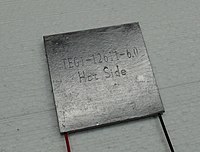
Photo from wikipedia
Abstract Cu‒Cr alloy is a kind of functional and structural integrated material with excellent comprehensive mechanical and electrical properties. However, due to the low solubility of Cr in Cu and… Click to show full abstract
Abstract Cu‒Cr alloy is a kind of functional and structural integrated material with excellent comprehensive mechanical and electrical properties. However, due to the low solubility of Cr in Cu and the huge difference in melting point, the existing methods to manufacture well-structured Cu‒Cr alloys are facing many challenges. In this paper, laser additive manufacturing (LAM) is applied to manufacture CuCr30 with ideal structure, taking advantage of its characteristics such as the small molten pool and fast crystallization. A small amount of microporosity defects formed during the LAM process were then reduced by severe shear deformation in the subsequent continuous extrusion process. As a result, the strength of the CuCr30 was increased by 55.3% and the room temperature conductivity was increased by 6.6%. Although the Cu grain refinement leads to fine grain strengthening and the homogenization of Cr distribution leads to enhancement of second phase strengthening during continuous extrusion, both have a negative effect on conductivity, the room temperature conductivity of CuCr30 did not decrease, because of the reduction of pore defects and the formation of nano-twinned structure with thickness of 10–30 nm, which improves the strength without affecting the conductivity.
Journal Title: Journal of Alloys and Compounds
Year Published: 2021
Link to full text (if available)
Share on Social Media: Sign Up to like & get
recommendations!